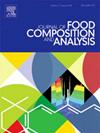摘要
本研究旨在分析不同品种玫瑰花茶的品质差异。研究采用超高效液相色谱-四极杆飞行时间质谱法(UPLC-Q-TOF-MS/MS)检测不同品种玫瑰花中的代谢物,以发现差异代谢物。气相色谱-离子迁移谱分析(GC-IMS)结果显示,不同品种的玫瑰中存在 15 种潜在的差异化合物,其中 1-戊烯-3-酮(单体)和丙酸乙酯是 6 个不同品种玫瑰中差异最大的两种物质。不同品种玫瑰花茶挥发性风味化合物的气相色谱-质谱分析表明,XS 玫瑰花茶中醛、醇、烷和酚的浓度最高,分别为 4.133 微克/克、14.873 微克/克、3.039 微克/克和 2.399 微克/克。KS 玫瑰花茶中酮、杂环化合物和醚的浓度最高,分别为 4.344 微克/克、0.752 微克/克和 0.234 微克/克。苯乙醇、香茅醇、辛酸乙酯和癸酸乙酯被认为是形成不同品种玫瑰花茶特有香气的主要因素。This study aimed to analyze the quality differences of different varieties of rose tea. Ultra-high-performance liquid chromatography-quadrupole-time-of-flight mass spectrometry (UPLC-Q-TOF-MS/MS) was used to detect the metabolites in different varieties of rose to find out the differential metabolites.Forty-four phenylpropionic acid and polyketone compounds were found to the main differential metabolites in 6 different varieties of roses. Gas chromatography ion mobility spectrometry (GC-IMS) results revealed the presence of 15 potential differential compounds among different varieties of roses, with 1-penten-3-one (monomer) and ethyl propionate being the two most significantly different substances among the six different varieties of roses. GC-MS analysis of volatile flavor compounds in different varieties of rose tea showed that the concentrations of aldehydes, alcohols, alkanes, and phenols in XS rose tea were the highest, being 4.133 µg/g, 14.873 µg/g, 3.039 µg/g, and 2.399 µg/g, respectively. The concentrations of ketones, heterocyclic compounds, and ethers in KS rose tea are the highest, being 4.344 µg/g, 0.752 µg/g, and 0.234 µg/g, respectively. Phenyl-ethanol, citronellol, octanoic acid ethyl ester, and decanoic acid ethyl ester are considered to be the main factors in the formation of characteristic aromas in different varieties of rose tea.

 求助内容:
求助内容: 应助结果提醒方式:
应助结果提醒方式:


